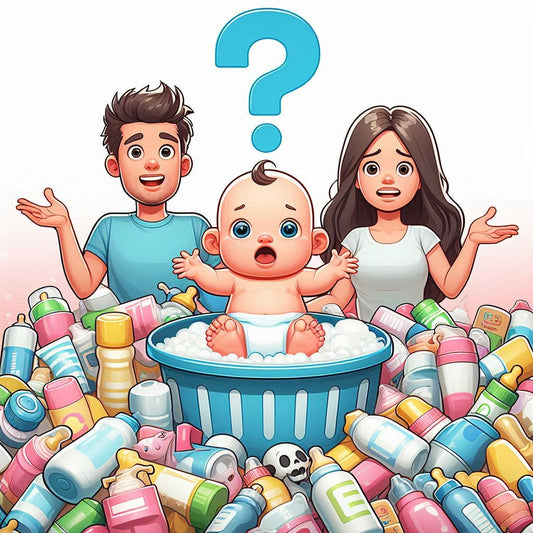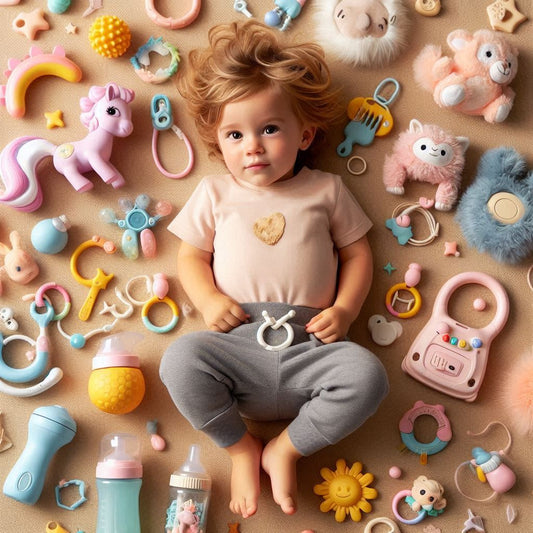How to Choose the Best Reusable Diapers in 2025 – Eco-Friendly, DIY-Inspired Cloth Options for Conscious and Creative Parenting
Kin BuBShare
In 2025, choosing reusable diapers is about more than just saving money or reducing waste—it’s about embracing a creative, conscious lifestyle that reflects your parenting values. Today’s cloth diaper options are more stylish, sustainable, and DIY-friendly than ever, making them a perfect match for parents who want to care for their baby and the planet while enjoying a hands-on approach to parenting.
Whether you're building a custom diaper stash, preparing for a baby shower, or curating an eco-conscious newborn gift basket, this guide will walk you through how to choose the right reusable diapers in 2025—based on materials, fit, care, and even creative uses.
Table of content
- 1. 🌿 Why Reusable Diapers Make Sense in 2025
- 2. ✅ Key Types of Reusable Diapers in 2025
- 3. 🧵 Materials Matter: Choosing the Right Fabrics
- 4. ✨ Sizing, Fit & Snaps in 2025
- 5. 🧽 Care & Washing Tips for Modern Reusables
- 6. 🎨 Creative & DIY Ways to Use Reusable Diapers
- 7. 🙋 Frequently Asked Questions
- 8. 📌 Conclusion: Make Every Change Count
🌿 Why Reusable Diapers Make Sense in 2025
Modern reusable diapers have come a long way from pins and plastic pants. Today’s options include sleek designs, adjustable sizing, and sustainable fabrics that feel as good as they perform. Choosing cloth diapers means:
- Reducing your carbon footprint (each baby uses ~6,000 diapers!)
- Saving money over time
- Avoiding exposure to chemical-laden disposables
- Supporting small, eco-friendly businesses
- Creating a personalized diaper system or gift
And yes—they’re totally compatible with handmade diaper bags, upcycled wipes, and embroidered liners. Welcome to the creative side of sustainable parenting!
✅ Key Types of Reusable Diapers in 2025
| Type | Description | Best For |
| All-in-One (AIO) | Diaper and absorbent layer sewn together; easy to use | New parents, daycare use |
| Pocket Diapers | Outer shell + insert pocket; customize absorbency | Parents who want flexibility |
| Prefolds/Flats | Folded cloth + waterproof cover; most economical | DIY lovers, budget-conscious families |
| Hybrid Systems | Use with reusable or disposable inserts | Families who travel often |
| Fitted Diapers | Shaped, absorbent fabric + separate cover | Overnight or heavy wetters |
🧵 Materials Matter: Choosing the Right Fabrics
In 2025, natural, breathable materials are more popular than ever. Consider these:
- Bamboo: Ultra-soft, antimicrobial, high absorbency
- Cotton (organic preferred): Durable and gentle, widely available
- Hemp: Sustainable, very absorbent, ideal for nighttime
- Microfiber: Quick drying, affordable, but must be kept away from skin
- Fleece (liners): Keeps baby’s skin dry; washable and cozy
Tip: Combine materials for optimal use—hemp for absorbency, bamboo for softness, and fleece for stay-dry comfort.
✨ Sizing, Fit & Snaps in 2025
Most reusable diapers are now one-size-fits-most with adjustable snaps or Velcro. But for the perfect fit:
- Newborn stage (0–12 lbs): Use specific newborn cloth diapers to avoid leaks
- Infant to toddler (8–35 lbs): Choose OS (one-size) with rise and waist snaps
- Chunky or slim babies: Seek brands with generous or trim cut options
2025 trends include:
- Crossover snaps for smaller babies
- Elastic-back pockets for easier stuffing
- Gender-neutral prints with pastel, nature, and animal themes
🧽 Care & Washing Tips for Modern Reusables
Good diaper care = longer lifespan + better performance.
Step-by-Step Washing Routine:
- Pre-rinse in cold (to remove waste)
- Hot wash with fragrance-free detergent
- Extra rinse to clear buildup
- Line dry when possible or tumble low (sun also helps with stains)
Care Tips:
- Use a wet bag for dirty diapers on the go
- Avoid fabric softeners—they coat the fibers
- Consider adding vinegar or baking soda for odor control (check brand advice)
- Use a diaper sprayer or liner to simplify solids cleanup
🎨 Creative & DIY Ways to Use Reusable Diapers
Cloth diapers are not just for function—they’re also a canvas for creativity!
1. Handmade Baby Shower Gift Set
- Pair 2–3 cloth diapers with reusable wipes, natural balm, and a custom diaper bag
- Include a mini card with washing instructions and eco-stats
2. DIY Embroidered Diaper Covers
- Personalize with baby’s initials, woodland animals, or favorite patterns
- Use OEKO-TEX® certified thread for safety
3. Keepsake Growth Chart with Retired Diapers
- Document your baby’s growth by preserving one adorable cloth diaper from each phase
- Frame or display them in a nursery shadow box
4. Reusable Diaper Craft Kit
- Upcycle old covers into bibs, pacifier clips, doll clothing, or snack bags
🙋 Frequently Asked Questions
1. Are reusable diapers sanitary?
Yes! When washed properly, reusable diapers are just as safe and sanitary as disposables—often more so, since you control the cleaning process.
2. How many diapers do I need to start?
For full-time cloth diapering:
- Newborn: 24–30
- Infant: 18–24
- Toddler: 12–18
3. Can I use reusable diapers while traveling?
Yes—pack hybrid systems or prefolds with covers, and use a wet bag to store used ones until wash day.
4. Are cloth diapers really better for the environment?
When washed efficiently and reused for multiple children, cloth diapers reduce landfill waste and chemical pollution significantly.
5. Can I sew my own diapers?
Absolutely! Many parents use free or purchased PDF patterns and eco-certified fabrics to make custom diapers at home.
6. Are reusable diapers safe for sensitive skin?
Yes—especially when using natural fibers like bamboo and organic cotton, with gentle, fragrance-free detergent.
📌 Conclusion: Make Every Change Count
Choosing reusable diapers in 2025 is more than a decision—it’s a statement of intention. Whether you're a creative soul who loves handmade solutions, a minimalist aiming to reduce waste, or a parent curating the perfect DIY baby gift, modern cloth diapers offer function, flexibility, and flair.
From soft bamboo inners to custom-embroidered covers, reusable diapers are redefining what it means to care—for your baby, your home, and the world they’ll grow into.




